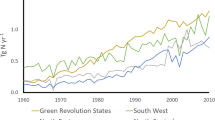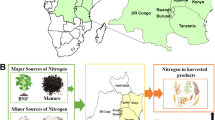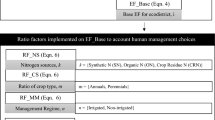Abstract
In most soils, formation and emissions of N2O to the atmosphere are enhanced by an increase in available mineral nitrogen (N) through increased rates of nitrification and denitrification. Therefore, addition of N, whether in the form of organic or inorganic compounds eventually leads to enhanced N2O emissions. Global N2O emissions from agricultural systems have previously been related primarily to fertilizer N input from synthetic sources. Little attention has been paid to N input from other N sources or to the N2O produced from N that has moved through agricultural systems. In a new methodology used to estimate N2O emissions on the country or regional scale, that is briefly described in this paper, the anthropogenic N input data used include synthetic fertilizer, animal waste (feces and urine) used as fertilizer, N derived from enhanced biological N-fixation through N2 fixing crops and crop residue returned to the field. Using FAO database information which includes data on synthetic fertilizer consumption, live animal production and crop production and estimates of N input from recycling of animal and crop N, estimates of total N into Asian agricultural systems and resulting N2O emissions are described over the time period 1961 through 1994.
During this time the quantity and relative amounts of different types of materials applied to agricultural soils in Asia as nitrogen (N) fertilizer have changed dramatically. In 1961, using the earliest entry from the FAO database, of the approximately 15.7 Tg of fertilizer N applied to agricultural fields 2.1 Tg N (13.5% of total N applied) was from synthetic sources, approximately 6.9 Tg N from animal wastes, 1.7 Tg N from biological N-fixation, and another 5 Tg N from reutilization of crop residue. In 1994, 40.2 Tg from synthetic fertilizer N (57.8% of total), 14.2 Tg from animal wastes, 2.5 Tg from biological N-fixation and 12.6 Tg from crop residue totalling 69.5 Tg N were utilized within agricultural soils in all Asian countries.
The increases in N utilization have increased the emission of nitrous oxide from agricultural systems. Estimated N2O from agricultural systems in Asia increased from about 0.8 Tg N2O-N in 1961 to about 2.1 in 1994. The period of time when increases in N input and resulting N2O emissions were greatest was during 1970–1990.
This evaluation of N input into Asian agricultural systems and the resulting N2O emissions demonstrates the large change in global agriculture that has occurred in recent decades. Because of the increased need for food production increases in N input are likely. Although the rate of increase of N input and N2O emissions during the 1990s appears to have declined, we ask if this slowed rate of increase is a general long term trend or if global food production pressures will tend to accelerate N input demand and resulting N2O emissions as we move into the 21st century.
Similar content being viewed by others
References
Bouwman AF (1996) Direct emission of nitrous oxide from agricultural soils. Nutr Cycl Agroecosyst 46: 53–70
Bouwman AF (1995) Compilation of a global inventory of emissions of nitrous oxide. Thesis Landbouwuniversiteit Wageningen, 143 pp
Bouwman AF & Van der Hoek KW (1991) Analysis of soil and water borne emissions of nitrous oxide and methane in the Netherlands. RIVM Report no. 736301010. National Institute of Public Health and Environmental Protection, Bilthoven, The Netherlands
Bouwman AF, Oliver JGJ & Van der Hoek KW (1995) Uncertainties in the global source distribution of nitrous oxide. J Geophys Res 100: 2785–2800
Bronson KF, Neue HU, Singh U & Abao EB (1997a) Automated chamber measurements of methane and nitrous oxide flux in a flooded rice soil: I. Residue, nitrogen, and water management. Soil Sci Soc Am J 61: 981–987
Bronson KF, Singh U, Neue HU & Abao EB (1997b) Automated chamber measurements of methane and nitrous oxide flux in a flooded rice soil: II. Fallow period emissions. Soil Sci Soc Am J 61: 988–993
Brown LR, Flavin C, Starke L et al. (1996) State of theWorld 1996. W.W. Norton & Company, New York, 249 pp
Chen GX, Huang GH, Huang B, Yu KW, Wu J & Xu H (1997) Nitrous oxide and methane emissions from soil-plant systems. Nutr Cycl Agroecosyst 49: 41–45
Eswaran H, Van den Berg E, & Reich P (1993) Organic carbon in soils of the world. Soil Sci Soc Am J 57: 192–194
FAO (1990a) Food and Agricultural Organization of the United Nations. Fertilizer Yearbook Volume 39. FAO statistics series No. 95. FAO, Rome
FAO (1990b) Food and Agricultural Organization of the United Nations. Crop Production Yearbook. Volume 43. FAO statistics series No. 94. FAO, Rome
Firestone MK & Davidson EA (1989) Microbiological basis of NO and N2O production and consumption in soil. In: Andreae MO & Schimel DS (eds) Exchange of Trace Gases between Terrestrial Ecosystems and the Atmosphere, pp 7–21. John Wiley and Sons Ltd. Chichester, UK
Freney JR, Denmead OT, Watanabe, I, & Craswell ET (1981) Ammonia and nitrous oxide losses following applications of ammonium sulfate to flooded rice. Aust J agric Res 32: 37–45
Groffman PM, Rice CW & Tiedje JM (1993) Denitrification in a tallgrass prairie landscape. Ecology 74: 855–862
IPCC (1990) Climate Change: The IPCC Scientific Assessment. IPCC Working Group I In: Houghton JT, Jenkins GJ & Ephraums JJ and WMO/UNEP (eds) Cambridge University Press, Cambridge, UK, 365 pp
IPCC (1992) Houghton JT et al. (eds) Climate Change (1992) The supplementary report to the IPCC Scientific assessment. Published for the IPCC, Cambridge University Press
IPCC (1995) Climate Change (1994) Radiative Forcing of Climate Change and an Evaluation of the IPCC IS92 Emission Scenarios. Houghton J T et al. (eds) Published for the IPCC, Cambridge University Press, Cambridge, UK, 337 pp
IPCC (1997) Intergovernmental Panel on Climate Change Guidelines for National Greenhouse Gas Inventories. Chapter 4. Agriculture: Nitrous oxide from agricultural soils and manure management. OECD, Paris, France: 4.1–4.140
Jarvis SC & Pain BF (1994) Greenhouse gas emissions from intensive livestock systems: their estimation and technologies for reduction. Climate Change 27: 27–38
Kroeze C (1994) Nitrous Oxide: Emission inventory and options for control in the Netherlands. Report Number 773001004. National Institute of Public Health and Environmental Protection, Bilthoven, The Netherlands, 163 pp
Meisinger JJ & Randall GW (1991) Estimating nitrogen budgets for soil-crop systems. In: Follett RF, Keeney DR & Cruse RM (eds) Managing Nitrogen for Groundwater Quality and Farm Profitability, pp 85–124. Soil Sci Soc Am Inc Madison, WI
Mosier AR, Duxbury JM, Freney JR, Heinemeyer O & Minami K (1996) Nitrous oxide emissions from agricultural fields: Assessment, measurement and mitigation. Plant Soil 181: 95–108
Mosier AR, Kroeze C, Nevison C, Oenema O, Seitzinger S & Van Cleemput O (1998) Closing the global atmospheric N2O budget: nitrous oxide emissions through the agricultural nitrogen cycle. Nutr Cycl Agroecosyst 52: 225–248
Tsuruta H, Kanda K & Hirose T (1997) Nitrous oxide emissions from a rice paddy field in Japan. Nutr Cycl Agroecosyst 49: 51–58
Xing GX & Zhu ZL (1997) Preliminary studies on N2O emission fluxes from upland soils and paddy soils in China. Nutr Cycl Agroecosyst 49: 17–22
Xu H, Xing GX, Cai ZC, Tsuruta H (1997) Nitrous oxide emission from rice fields of three regions in China. Nutr Cycl Agroecosyst 49: 23–28
Author information
Authors and Affiliations
Corresponding author
Rights and permissions
About this article
Cite this article
Mosier, A.R., Zhaoliang, Z. Changes in patterns of fertilizer nitrogen use in Asia and its consequences for N2O emissions from agricultural systems. Nutrient Cycling in Agroecosystems 57, 107–117 (2000). https://doi.org/10.1023/A:1009716505244
Issue Date:
DOI: https://doi.org/10.1023/A:1009716505244




